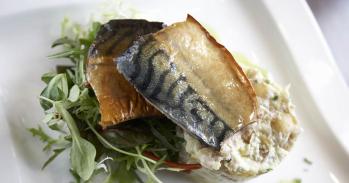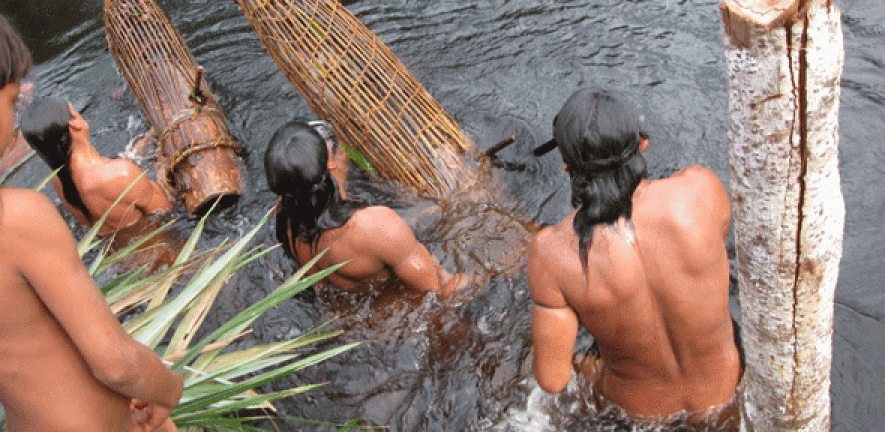
The Enawenê-nawê people of the Amazon rainforest make beautifully engineered fishing dams. Living alongside this indigenous community, Dr Chloe Nahum-Claudel observed how the act of trapping fish shapes their minds, bodies and relationships. The proximity of life and death brings human vulnerability sharply into focus.
The Enawenê-nawê people of the Amazon rainforest make beautifully engineered fishing dams. Living alongside this indigenous community, Dr Chloe Nahum-Claudel observed how the act of trapping fish shapes their minds, bodies and relationships. The proximity of life and death brings human vulnerability sharply into focus.
The men live for the traps, devoting themselves to animating them so that they will catch plenty of fish.
Chloe Nahum-Claudel
Hunting brings us close to our prey but the blood of a dying animal, spilling on to our hands, reminds us of our own mortality. Trapping, the use of technology to entice and capture, distances us from the act of killing. But, in their making and their function, traps connect our minds and bodies to the animals we pursue.
Each year, the Enawenê-nawê, an indigenous community in the Amazon, construct monumental fishing dams to harvest migrating fish vital to their diet. Social anthropologist Dr Chloe Nahum-Claudel carried out her PhD fieldwork with this community, learning a dialect spoken by fewer than 1,000 people. She spent six weeks living alongside a group of 12 men as they constructed a dam.
She says: “I’m interested in the relationship between people’s practical economic lives and how they see the universe. My research with the Enawenê-nawê suggests that their dams are much more than a means to obtain food. The process shapes their minds, bodies and relationships with one another, with their prey, and with spirits and ancestors. My research was timely because these technologies are threatened by the construction of hydroelectric dams in many of the Amazon’s tributaries.”
The process of making traps became a particular focus for Nahum-Claudel when, as she explains, she realised that we touch on our own vulnerability every time we catch another living creature and subject it to our wishes. She recently convened a conference to consider trap-making and how these activities can be used to approach the relationship between humans and other species.
“To trap an animal you have to be very knowledgeable about its habits, its preferences and its weaknesses, and then you have to put all this knowledge into the making of an effective trap, and the placement and disguise of your equipment. That’s why traps offer an interesting way to approach practical encounters between ourselves and other species,” she says.
“I also realised that this was a neglected field of research. There’s been a lot written about hunting – and trapping is one method of catching prey. But unlike hunting, trapping doesn’t have to be fatal; ornithologists studying bird migrations have to trap birds and camera-traps are used to monitor tigers in India. I was interested in bringing people together to see if there were overlaps in the practice of trapping in such diverse contexts.”
Nahum-Claudel’s conference paper, which will form the first chapter of her forthcoming book, describes the Enawenê-nawê’s fishing technology and how it shapes them. The Enawenê-nawê are pescatarians who employ a variety of fishing techniques depending on the seasonal opportunities.
The most impressive and unusual of these technologies are fishing dams built to coincide with the downstream migration of shoal-living fish, which spawn in the flooded forest during the rainy season. Each year teams of fishermen leave their large village while the fish are busy feasting and spawning and set to work building dams to trap the fish as they try to return downstream, once the river levels start to fall.
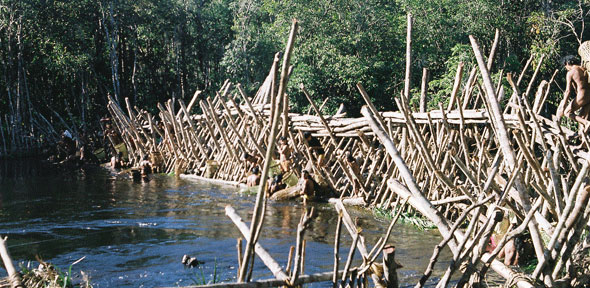
These dams are two-part technologies. In the first week or so, the men make a weir across the river using timber, bark and lianas from the surrounding forest. Men float the logs downriver and then dive into the fast flowing water to anchor them in the river bed. Frail, elder men later make nets to catch jumping fish. Ideally, the weir closes off the entire river so that not one fish can escape.
Once the weir is complete, the team turn their attention to making 100 or so man-sized traps which are crafted from cylinders of bark and basketry woven from the ribs of palm fronds. The special bark cylinders, which are said to resemble men’s thorax are prised off of tree trunks like waist coats, and must not snap. The completed trap is man-sized and phallic-looking.
In her paper, Nahum-Claudel explains that the activities of weir-building and trap-making demand different kinds of effort and imply contrasting kinds of sociability for the community. As the men construct the weir, moving vigorously between the forest and the water, they liken themselves to the creator deity who built the first dam as he made the world. Like him, they are masters of the boundary between land and water, which, as fisher people, is the crucial one in their universe.
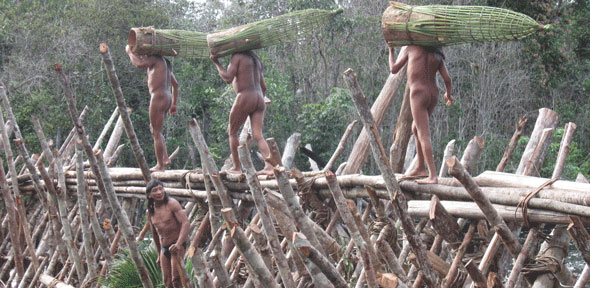
She says: “What I mean by mastery is clear in the expression men use to describe the fish’s demise. They say that the fish ‘drown in the traps’. Men create the conditions in which the fish drown in their own watery dominion and, what’s more, the fish bring about their downfall by entering the traps out of their own curiosity and desire. When the men make traps, the seated handiwork makes them more contemplative. As anyone who does craftwork knows, the activity of making something with your hands encourages a mood of reflection and brings about identification with the object crafted.”
While weir-building is physically demanding and highly organised, tending the traps is more restful and is described by the Enawenê-nawê themselves as ‘lying down to rest’. Camped downstream of the dam, the men may be physically absent but their thoughts and actions are understood to have an impact on their traps’ ability to capture fish – precisely because the trap never loses its bond with the man who has crafted it.
“The men live for the traps, devoting themselves to animating them so that they will catch plenty of fish,” says Nahum-Claudel. “They whisper to their traps and utter magical incantations. Sweet-smelling leaves are rubbed on the mouths of the traps to make them enticing to the fish. The team self-consciously strives to create a joyful atmosphere which the traps ‘desire’. There is much sexual banter – it’s locker-room talk all the time – and I was constantly reminded that I should not be grumpy, argumentative or stingy so as not to sour the mood.”
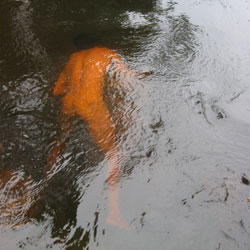
These practices seem to be about ensuring the traps’ efficacy and protecting the men themselves. Both of these aspects are thought of in terms of fertility. The traps are said to enter the weir ‘like a penis penetrating for the first time’ and the fish are seduced into entering their fragrant openings. As soon as they set the traps in place, the fishermen say that they become like virgins who have had sex for the first time.
“It is as if the traps were their own penises,” Nahum-Claudel says, “because their insertion thrusts men into the same state of vulnerability as teenage boys experience after they have had sex for their first time and their partner bleeds”. Through sex, men become open to the blood of women and they must exercise care in what they eat and in the activities they undertake when their wives menstruate or give birth. The first time this happens to a teenage boy, the restrictions to his activity and diet are strict – he lies down to rest and fast in his hammock for several days.
When the traps enter the weir the team of fishermen act in a very similar way, they fast and they say that they are now ‘lying down to rest’. This suggests that men are open to the blood of the fish caught in the traps – traps which are connected to their own bodies – just as they are open to the blood of women. Nahum-Claudel suggest that the dam fishing endeavour is about mitigating the risks involved in shedding blood while, at the same time, using the channel that exists between traps and men to promote the traps’ fertility. A theme that crops up repeatedly in Enawenê-nawê mythology is that the tables can easily turn and predator can become prey.
“Traps are all about hubris,” says Nahum-Claudel, “men build a deadly dam and drown fish in their own dominion. This activity is playing God, but everything about the men’s behaviour suggests that they are acutely aware of how risky this is, that it could – like a tragic play – end in their own downfall. What they stress as they trap the fish is not their Deity-like mastery but rather the subjection it implies. This feeling fits with the experiences of hunters and fishermen around the world. The proximity of life and death brings into focus human vulnerability so that hunting is rarely a question of unalloyed heroism. Enawenê-nawê dam fishing takes this to extremes because it is based on a monumental technology and entails intensive subjective and social involvement by the fishermen.”
Inset images from top: men harvest fish from their traps at Olowina River’s dam; the traps are ready to be inserted into the upriver face of a dam at Maxikywina River; a man dives down to pull up his trap from its position near the river bed. All photos: Chloe Nahum-Claudel, 2009. Nahum-Claudel's book is now available.

The text in this work is licensed under a Creative Commons Attribution 4.0 International License. For image use please see separate credits above.

